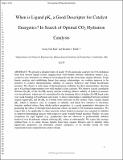When Is Ligand pK[subscript a] a Good Descriptor for Catalyst Energetics? In Search of Optimal CO₂ Hydration Catalysts
Author(s)
Kim, Jeong Yun; Kulik, Heather Janine
DownloadKimJPCA18_OA.pdf (1021.Kb)
Publisher Policy
Publisher Policy
Article is made available in accordance with the publisher's policy and may be subject to US copyright law. Please refer to the publisher's site for terms of use.
Terms of use
Metadata
Show full item recordAbstract
We present a detailed study of nearly 70 Zn molecular catalysts for CO₂ hydration from four diverse ligand classes ranging from well-studied carbonic anhydrase mimics (e.g., cyclen) to new structures we obtain by leveraging diverse hits from large organic libraries. Using microkinetic analysis and establishing linear free energy relationships, we confirm that turnover is sensitive to the relative thermodynamic stability of reactive hydroxyl and bound bicarbonate moieties. We observe a wide range of thermodynamic stabilities for these intermediates, showing up to 6 kcal/mol improvement over well-studied cyclen catalysts. We observe a good correlation between the pKa of the Zn–OH₂ moiety and the resulting relative stability of hydroxyl moieties over bicarbonate, which may be rationalized by the dominant effect of the difference in higher Zn−OH bond order in comparison to weaker bonding in bicarbonate and water. A direct relationship is identified between isolated organic ligand pK[subscript a] and the pK[subscript a] of a bound water molecule on the catalyst. Thus, organic ligand pK[subscript a], which is intuitive, easy to compute or tabulate, and much less sensitive to electronic structure method choice than whole-catalyst properties, is a good quantitative descriptor for predicting the effect of through-bond electronic effects on relative CO₂ hydration energetics. We expect this to be applicable to other reactions where is it essential to stabilize turnover-determining hydroxyl species with respect to more weakly bound moieties. Finally, we note exceptions for rigid ligands (e.g., porphyrins) that are observed to preferentially stabilize hydroxyl over bicarbonate without reducing pKa values as substantially. We expect the strategy outlined here, to (i) curate diverse ligands from large organic libraries and (ii) identify when ligand-only properties can determine catalyst energetics, to be broadly useful for both experimental and computational catalyst design.
Date issued
2018-04Department
Massachusetts Institute of Technology. Department of Chemical EngineeringJournal
Journal of Physical Chemistry A
Publisher
American Chemical Society (ACS)
Citation
Kim, Jeong Yun and Heather J. Kulik. "When Is Ligand pK[subscript a] a Good Descriptor for Catalyst Energetics? In Search of Optimal CO₂ Hydration Catalysts." Journal of Physical Chemistry A 122, 18 (April 2018): 4579-4590 © 2018 American Chemical Society
Version: Final published version
ISSN
1089-5639
1520-5215